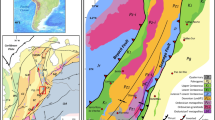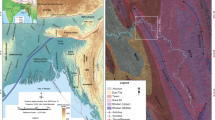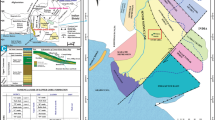Abstract
The Cretaceous Mishrif Formation in the west UAE, East Rub al Khali Basin has got new discoveries; however, there is a lack of systematic and detailed research on the sedimentology, sequence stratigraphy and reservoir distribution of Mishrif Fm. Based on large amount of core and thin section observations, well logging and seismic interpretation, the sedimentary facie association, sequence stratigraphy, and sedimentary evolution of the Mishrif Formation are studied. Moreover, the distribution law and quality of the reservoir are characterized and evaluated. A set of platform carbonate rocks deposited as the Mishrif Formation in the research area, and five typical facie associations are recognized, including rudist-bearing reef, grain shoal, inter-shoal channel/hollow and fore-shoal slope. On this basis, a comprehensive sedimentary evolution model is established. The Mishrif Formation is interpreted as three third-order sequences and six forth-order sequences. In SQ1 and SQ2 sequences, a set of rimmed platform deposited, and ramp deposited in SQ3. Multi-stage platform margins and rudist-bearing reefs develop in HST (highstand systems tract cycles), and successively progradation to the Shilaif sub-basin in the east. The Mishrif reservoir is mostly composed of rudstone, grainstone, and packstone, with well-developed intergranular and dissolved pores. The total porosity reaches above 20%, and the permeability is 1–100 md. The reservoir quality is strongly controlled by facies’ associations and dissolution near sequence boundaries. Reef-shoal reservoirs near sequence boundaries in top of HST have higher porosity and permeability than those in other facies belts and position of sequence.

















Similar content being viewed by others
Data Availability Statement
Data is not available for confidential reasons.
References
Ali MY, Watts AB, Searle MP (2013) Seismic stratigraphy and subsidence history of the United Arab Emirates (UAE) rifted margin and overlying foreland basins. In: Hosani KA, Roure F, Ellison R, Lokier S (eds) Lithosphere dynamics and sedimentary basins: the arabian plate and analogues. Springer, pp 127–143
Ali MY, Watts AB (2009) Subsidence history, gravity anomalies and flexure of the United Arab Emirates (UAE) foreland basin. GeoArabia 14:17–44
Alsharhan AS (1995a) Sedimentology and depositional setting of the Late Cretaceous Fiqa Formation in the United Arab Emirates. Cretac Res 16:39–51
Alsharhan AS (1995b) Facies variation, diagenesis, and exploration potential of the cretaceous rudist-bearing carbonates of the Arabian gulf. AAPG Bull 79(4):531–550
Amer JAK (2015) The Mishrif, Yamama, and Nahr Umr reservoirs petroleum system analysis, Nasiriya oilfield, southern Iraq. Arab J Geosci 8(2):781–798
Aqrawi AAM, Thehni GA, Sherwani GH et al (1998) Mid-cretaceous rudist-bearing carbonates of the Mishrif Formation: an important reservoir sequence in the Mesopotamian basin, Iraq. J Pet Geol 21(1):57–82
Aqrawi AAM, Goff JC, Horbury A et al (2010) The petroleum geology of Iraq. Scientific Press, Beaconsfield, p 424
Azzam IN, Taher AK (1993) Sequence stratigraphy and source ’rock potential of middle cretaceous (upper Wasia Group) in West Abu Dhabi. SPE 25577:475–487
Bian CS, Li YX, Lv MS, et al. (2022) Sedimentary evolution model and sedimentary facies distribution of carbonaterocks: case study of Mishrif Formation in northeast Rub Khali Basin. Nat Gas Geosci 33(4):1–11 (in Chinese)
Cantrell DL, Shah RA, Ou J et al (2020) Depositional and diagenetic controls on reservoir quality: Example from the upper Cretaceous Mishrif Formation of Iraq. Mar Pet Geol 118:1–34
Deng Y, Guo R, Tian ZY et al (2016) Geologic features and genesis of the barriers and intercalations in carbonates: a case study of the Cretaceous Mishrif Formation, West Qurna oil field, Iraq. Pet Explor Dev 43(01):140–148 (in Chinese)
Du JH, Zou CN, Xu CC et al (2014) Theoretical and technical innovations in strategic discovery of a giant gas field in Cambrian Longwangmiao Formation of central Sichuan paleo-uplift, Sichaun basin. Petrol Explor Dev 41(3):268–277 (in Chinese)
Dunham RJ (1962) Classification of carbonate rocks according to depositional texture. In: Ham WE (ed) Classification of carbonate rocks. AAPG Memoir 1, pp 108–121
Ehrenberg SN (2019) Petrophysical heterogeneity in a lower cretaceous limestone reservoir, onshore Abu Dhabi, United Arab Emirates. AAPG Bull 103:527–546
Ehrenberga SN, Zhanga J, Gomesb JS (2020) Regional variation of permeability in Thamama-B reservoirs of Abu Dhabi. Mar Pet Geol 116:1–15
Fang SX, Hou FH (2013) Diagenesis of carbonate rocks. Geological Publishing Press (in Chinese)
Flugel E (2006) Microfacies of carbonate rocks (Ma Yongsheng, trans). Beijing: Geological Publishing House, pp 628–696
Gao JX, Tian CB, Zhang WM et al (2013) Characteristics and genesis of carbonate reservoir of the Mishrif Formation in the Rumaila oil field, Iraq. Acta Pet Sin 34(5):843–852 (in Chinese)
Hajikazemi E, Aasm IS, Coniglio M (2010) Subaerial exposure and meteoric diagenesis of the Cenomanian-Turonian upper Sarvak Formation, southwestern Iran. Geol Soc Lond Spec Publ 330:253–272
Hong HT, Wang YG, Yang TQ et al (2008) Sedimentary facies of Changxing formation and distribution of organic reef gas reservoirs in northern Sichuan basin. Nat Gas Ind 28(1):38–41 (in Chinese)
Jean PM, Jean B, Salim AM (1998) A platform-to-basin transition for lower Aptian carbonates (Shuaiba Formation) of the northeastern Jebel Akhdar (Sultanate of Oman). Sediment Geol 119(3):297–309
John G, Zuwaina AR (2014) Depositional facies and platform architecture of microbialite-dominated carbonate reservoirs, Ediacaran-Cambrian Ara Group, Sultanate of Oman. AAPG Bull 98:1453–1494
Li HT (2013) Diagenesis and characteristics of reservoir in the member 3 of the lower triassic Feixianguan formation in Heba gas field. Acta Pet Sin 02:263–271 (in Chinese)
Li FF, Guo R, Liu LF et al (2020a) Heterogneity genesis of limestone reservoirs of cretaceous Mishrif Formation in M oilfield, Iraq. J Earth Sci Environ 42(3):297–312 (in Chinese)
Li FF, Guo R, Yu YC et al (2020b) Sedimentary characteristics and control in reservoirs in the cretaceous Mishrif Formation, M oilfield, Iraq. Acta Sedimentol Sin 38(5):1076–1087 (in Chinese)
Mahdi TA, Aqrawi AAM (2014) Sequence stratigraphic analysis of the mid-cretaceous Mishrif Formation, southern Mesopotamian basin. IRAQ J Petrol Geol 37(3):287–312
Mahdi TA, Aqrawi AAM, Horbury AD et al (2013) Sedimentological characterization of the Mid-Cretaceous Mishrif reservoir in southern Mesopotamian Basin, Iraq. Geoarabia 18(1):139–174
Malte SST, Parente M. Chronostratigraphy of campanian–maastrichtian platform carbonates and rudist associations of salento (apulia, Italy). Cretaceous Research, 2008a, 29(1):0–114
Malte SST, Parente M (2008b) Chronostratigraphy of campanian–maastrichtian platform carbonates and rudist associations of salento (Apulia, Italy). Cretaceous Res 29(1):0–114
Mazeel MA (2012) Hydrocarbon reservoir potential estimated for Iraq bid round block. Oil Gas J
Mohammed JA (2020) Microfacies analysis and depositional development of Shuaiba formation in the West Qurna oil field, Southern Iraq. Model Earth Syst Environ, pp 1–11
Ni Xi F, Chen HD, Tian JC et al (2007) Sedimentary framework of Changxing-Feixianguan formations and its control on reservoiring in northeastern Sichuan basin. Oil Gas Geol 28(4):458–465 (in Chinese)
Paola R, Andrea O, Ornella B, et al (2010) Zempolich. Depositional setting and diagenetic processes and their impact on the reservoir quality in the late Visean–Bashkirian Kashagan carbonate platform (Pre-Caspian Basin, Kazakhstan). AAPG Bull 94(9):1313–1348
Philip JM, Airaud CC (1991) The demise of the rudist-bearing carbonate platforms at the cenomanian/turonian boundary: a global control. Coral Reefs 10(2):115–125
Philippe L, François F, John JGR et al (2014) Diagenetic patterns and pore space distribution along a platform to outer-shelf transect (Urgonian limestone, Barremian-Aptian, SE France). Sed Geol 306:1–23
Sharland P R, Archer R, Casey D M, et al. (2001) Arabian plate sequence stratigrahy sequence. Bahrain: Gulf PetroLink, pp 10–100
Taghavi AA, Mork A, Emadi MA (2006) Sequence stratigraphically controlled diagenesis governs reservoir quality in the carbonate Dehluran Field, southwest Iran. Pet Geosci 12:115–126
Vail PR (1988) Sequence stratigraphy workbook, fundamentals of sequence stratigraphy. In: AAPG Annual convention short course, pp 217–259
Van B, Razin F, Homewood P et al (2002) Stratigraphic organization of carbonate ramps and organic intrashelf basins: Natih Formation (middle Cretaceous) of northern Oman. AAPG Bull 86:21–54
Wagoner JCV (1995) Sequence stratigraphy: an integrated technique for exploration and exploitation, part I: concepts and well log, core, and outcrop examples. Seg Techn Progr Expand Abstr 14(1):1521
Wang J, Guo R, Zhao LM et al (2016) Geological features of grain bank reservoirs and the main controlling factors: a case study on Cretaceous Mishrif Formation, Halfaya oilfield, Iraq. Petrol Explor Dev 43(3):367–377 (in Chinese)
Wilson JL (1975) Carbonate facies in geologic history. Springer, New York
Yu YC, Sun LD, Song XM et al (2018) Sedimentary diagenesis of rudist shoal and its control on reservoirs: a case study of Cretaceous Mishrif Formation, H Oilfield, Iraq. Petrol Explor Dev 45(06):89–101 (in Chinese)
Zeng DM, Wang XZ, Shi X et al (2010) Characteristic and reservoir property of the Leikoupo formation of middle Triassic in northwestern Sichuan Basin. Acta Sedimentol Sin 28(1):42–49 (in Chinese)
Zhang JL (2017) Carbonate sequence sedimentary evolution and control of sea level: a case study of Ordovician in the Gucheng area, Tarim basin. Nat Gas Ind 1:46–53 (in Chinese)
Zhao ZJ (2015) Indicators of global sea-level change and research methods of marine tectonic sequence: take Ordovician of Tarim Basin as an example. Acta Pet Sin 36(3):262–273 (in Chinese)
Ziegler MA (2001) Late Permian to Holocene paleofacies evolution of the Arabian Plate and its hydrocarbon occurrences. GeoArabia 6(3):445–504
Zou CN, Du JH, Xu CC et al (2014) Formation, distribution, resource potential and discovery of the Sinian-Cambrian giant gas field, Sichuan Basin, SW China. Petrol Explor Dev 41(3):278–293 (in Chinese)
Acknowledgements
The primary data and research process used in this paper are supported and guided by Abu Dhabi Project of Middle East Company, PetroChina.
Author information
Authors and Affiliations
Corresponding author
Additional information
Publisher's Note
Springer Nature remains neutral with regard to jurisdictional claims in published maps and institutional affiliations.
Rights and permissions
Springer Nature or its licensor holds exclusive rights to this article under a publishing agreement with the author(s) or other rightsholder(s); author self-archiving of the accepted manuscript version of this article is solely governed by the terms of such publishing agreement and applicable law.
About this article
Cite this article
Bian, C., Yang, T., Zhang, Q. et al. Sedimentology, sequence stratigraphy and their control on reservoirs quality in mid-Cretaceous Mishrif formation in East Rub al Khali Basin, Western UAE. Carbonates Evaporites 37, 71 (2022). https://doi.org/10.1007/s13146-022-00814-0
Accepted:
Published:
DOI: https://doi.org/10.1007/s13146-022-00814-0




